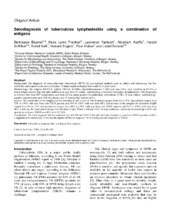| dc.contributor.author | Beyene, Demissew Balcha | en_US |
| dc.contributor.author | Franken, Kees Lumc | en_US |
| dc.contributor.author | Yamuah, Lawrence | en_US |
| dc.contributor.author | Aseffa, Abraham | en_US |
| dc.contributor.author | Wiker, Harald G. | en_US |
| dc.contributor.author | Kolk, Arend | en_US |
| dc.contributor.author | Engers, Howard | en_US |
| dc.contributor.author | Klatser, Paul R. | en_US |
| dc.contributor.author | Sviland, Lisbet | en_US |
| dc.date.accessioned | 2011-03-31T13:00:08Z | |
| dc.date.available | 2011-03-31T13:00:08Z | |
| dc.date.issued | 2010 | eng |
| dc.Published | Journal of Infection in Developing Countries 4(2): 96-102 | en_US |
| dc.identifier.issn | 1972-2680 | |
| dc.identifier.uri | https://hdl.handle.net/1956/4619 | |
| dc.description.abstract | Background: The diagnosis of extra-pulmonary tuberculosis (EPTB) by conventional methods such as culture and microscopy has low sensitivity and requires an invasive procedure. A simple rapid serological test would be of great value. Methodology: Six antigens (ESAT-6, Ag85A, TB10.4, Rv3881c, lipoarabinomannan (LAM) and Ara6-BSA) were tested in an ELISA to detect antigen-specific IgG and IgM antibodies in sera from 54 culture- and histology-confirmed tuberculous lymphadenitis (TBLN) patients as follows: four were HIV seropositive; sera from 25 was smear positive for pulmonary tuberculosis (PTB); 15 were culture- and histology-negative lymphadenitis (non-TBLN) patients; and 22 werehealthy controls (HCs). Results: The sensitivities of the antigens for the detection of IgG in sera of TBLN patients ranged from 4% to 30%. Specificities ranged from 73% to 100% with sera from non-TBLN patients and 91% to 100% with sera from HCs. Sensitivities of the antigens for detection of IgM ranged from 0% to 15% and specificities ranged from 80% to 100% with sera from non-TBLN patients and 91% to 100% with sera from HCs. LAM was the most potent antigen for detection of IgG. When LAM and ESAT-6 were combined, sensitivity increased up to 43% and specificity with non-TBLN was 80% with HC 96%. Conclusions: The study suggests that the combined use of LAM and ESAT-6 for IgG antibody detection in sera from TBLN patients could be a supplement to microscopy of fine-needle aspirate (FNA) to diagnose TBLN among patients suspected of TBLN. | en_US |
| dc.language.iso | eng | eng |
| dc.publisher | Open Learning on Enteric Pathogens | eng |
| dc.rights | Attribution CC BY | eng |
| dc.rights.uri | http://creativecommons.org/licenses/by/3.0/ | eng |
| dc.subject | Tuberculous lymphadenitis | eng |
| dc.subject | Serological test | eng |
| dc.subject | Antigens | eng |
| dc.title | Serodiagnosis of tuberculous lymphadenitis using a combination of antigens | en_US |
| dc.type | Peer reviewed | |
| dc.type | Journal article | |
| dc.description.version | publishedVersion | en_US |
| dc.rights.holder | Copyright 2010 Beyene et al. | |
| dc.rights.holder | Beyene et al. | |
| dc.identifier.cristin | 344941 | |
| dc.subject.nsi | VDP::Medical disciplines: 700::Clinical medical disciplines: 750::Communicable diseases: 776 | eng |

